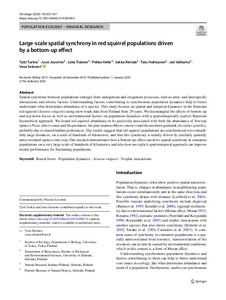Large-scale spatial synchrony in red squirrel populations driven by a bottom-up effect
Rintala Jukka; Tiainen Juha; Turkia Tytti; Valkama Jari; Hokkanen Tatu; Jousimo Jussi; Helle Pekka; Selonen Vesa
Large-scale spatial synchrony in red squirrel populations driven by a bottom-up effect
Rintala Jukka
Tiainen Juha
Turkia Tytti
Valkama Jari
Hokkanen Tatu
Jousimo Jussi
Helle Pekka
Selonen Vesa
SPRINGER
Julkaisun pysyvä osoite on:
https://urn.fi/URN:NBN:fi-fe2021042824335
https://urn.fi/URN:NBN:fi-fe2021042824335
Tiivistelmä
Spatial synchrony between populations emerges from endogenous and exogenous processes, such as intra- and interspecific interactions and abiotic factors. Understanding factors contributing to synchronous population dynamics help to better understand what determines abundance of a species. This study focuses on spatial and temporal dynamics in the Eurasian red squirrel (Sciurus vulgaris) using snow-track data from Finland from 29 years. We disentangled the effects of bottom-up and top-down forces as well as environmental factors on population dynamics with a spatiotemporally explicit Bayesian hierarchical approach. We found red squirrel abundance to be positively associated with both the abundance of Norway spruce (Picea abies) cones and the predators, the pine marten (Martes martes) and the northern goshawk (Accipiter gentilis), probably due to shared habitat preferences. The results suggest that red squirrel populations are synchronized over remarkably large distances, on a scale of hundreds of kilometres, and that this synchrony is mainly driven by similarly spatially autocorrelated spruce cone crop. Our research demonstrates how a bottom-up effect can drive spatial synchrony in consumer populations on a very large scale of hundreds of kilometres, and also how an explicit spatiotemporal approach can improve model performance for fluctuating populations.
Kokoelmat
- Rinnakkaistallenteet [19207]
